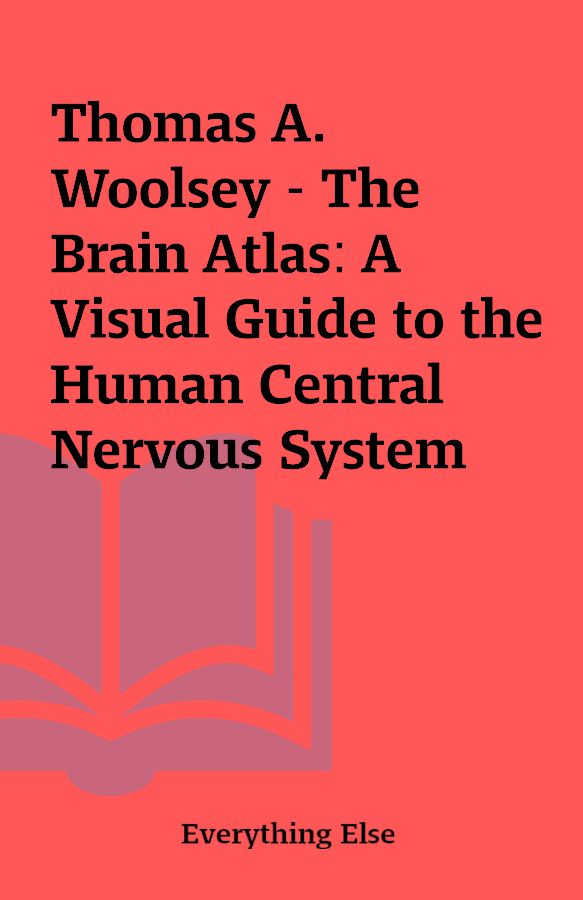Thomas A. Woolsey – The Brain Atlas: A Visual Guide to the Human Central Nervous System
The Brain Atlas – Thomas A. Woolsey
[1 Ebook – 1 AZW3 , 1 Mobi,1 Epub, 1 PDF]
Description
The Brain Atlas: A Visual Guide to the Human Central Nervous System 4th Editionby Thomas A. WoolseyEnglish | 31 Mar. 2017 | ISBN: 1118438779 | 272 Pages | AZW3/MOBI/EPUB/PDF (conv) | 108.15 MBThe Brain Atlas: A Visual Guide to the Human Central Nervous System integrates modern neuroscience with clinical practice and is now completely revised and updated for a Fourth Edition. Each page uses direct labeling system, including an alphabetical list of terms for each image Presents unrivaled treatment of brain pathways, with colored lines that clearly trace pathways over actual brain slices used earlier in the book Over 400 high quality images, including multiple magnetic resonance images side-by-side with corresponding brain slices Blood supply maps consistently and methodically presented with exhaustive depictions of arteries and blood territory maps next to each brain slice Print edition comes with free access to Wiley companion digital edition accessible on any device, allowing the reader to make notes, bookmark, follow cross references, and download figures Table of ContentsPreface.Acknowledgments.Part I: Introduction.Overview.The Nervous System.Using This Book.Materials and Methods.References.Part II: The CNS and Its Blood Vessels.Brain.Brain Stem.Cerebellum.Spinal Cord.Fiber Bundles.Part III: Brain Slices.Coronal Sections.Sagittal Sections.Axial Sections.Part IV: Histological Sections.Cerebellum.Brain Stem.Spinal Cord.Basal Ganglia and Thalamus.Hypothalamus.Basal Forebrain.Hippocampus.Part V: Pathways.Brain Stem.Thalamus.Hypothalamus.Sensory Systems.Sensory/Motor Systems.Motor Systems.Cerebellum.Basal Ganglia.Arousal and Sleep.Hippocampus.Amygdala.Hypothalamus.Autonomic Systems.Modulatory Systems.Index.Author InformationThomas A. WoolseyLecturer in Biology; George H. and Ethel R. Bishop Scholar in Neuroscience Emeritus; Professor Emeritus of Experimental Neurological Surgery, of Experimental Neurology, of Anatomy and Neurobiology, of Cell Biology and Physiology and of Biomedical Engineering, Washington University School of MedicineSt Louis, MO, USAJoseph HanawayRetired Clinical Assistant Professor of Neurology, Washington University School of Medicine,St Louis, MO, USAMokhtar H. GadoFormerly Professor of Radiology, Mallinckrodt Institute of Radiology,Washington University School of Medicine,St Louis, MO, USANew to This Edition New edition features large number of all-new and updated images New images reflect latest updates in imaging equipment and techniques Text components have been carefully rewritten to include wider, non-technical audience, making the book ideal as a text as well as a reference. Truly integrates modern neuroscience with clinical practiceReviews”The Brain Atlas serves as an authoritative reference work and learning tool for the brain and central nervous system. The work is essential fo rthe personal libraries of students, practioners, and researchers in neuroscience biology, psychiatry, and psychology, among other disciplines, as well as for libraries supporting both undergraduate and graduate course in school of medicine or health care facilities. The Brain Atlas is a worthwhile addition to any such collection, either as a replacement of or supplement to previous editions of the title.” (E-Streams, December 2008)”This reference book will serve as an outstanding resource for all students of neuroscience ⦠.This Atlas will become a much sought after companion.” (Journal of Tropical Pediatrics, August 2008)”â¦excellent contribution to the neurosciences. It should be included in any neurosurgical, neurological, or neurosciences departmental libraries.” (Doody’s Book Reviews)Wiley: http://eu.wiley.com/WileyCDA/WileyTitle/productCd-0470084766…
You must be logged in to post a review.






Reviews
There are no reviews yet.